Ambiq Micro超低功耗MCU突破EEMBC
- 格式:docx
- 大小:12.06 KB
- 文档页数:3
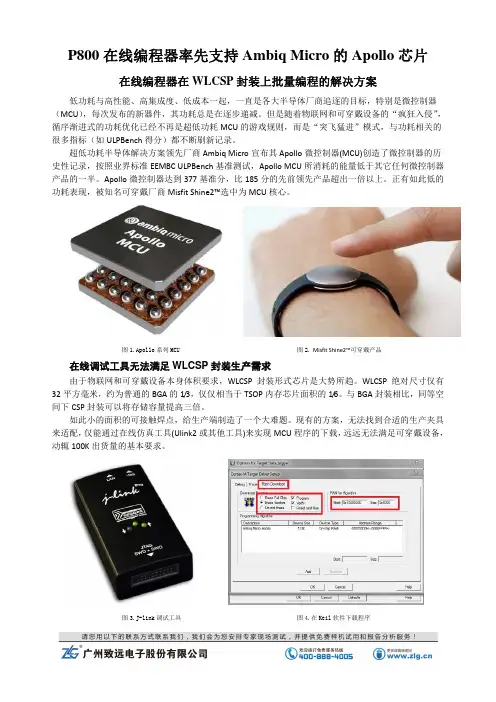
P800在线编程器率先支持Ambiq Micro的Apollo芯片在线编程器在WLCSP封装上批量编程的解决方案低功耗与高性能、高集成度、低成本一起,一直是各大半导体厂商追逐的目标,特别是微控制器(MCU),每次发布的新器件,其功耗总是在逐步递减。
但是随着物联网和可穿戴设备的“疯狂入侵”,循序渐进式的功耗优化已经不再是超低功耗MCU的游戏规则,而是“突飞猛进”模式,与功耗相关的很多指标(如ULPBench得分)都不断刷新记录。
超低功耗半导体解决方案领先厂商Ambiq Micro宣布其Apollo微控制器(MCU)创造了微控制器的历史性记录,按照业界标准EEMBC ULPBench基准测试,Apollo MCU所消耗的能量低于其它任何微控制器产品的一半。
Apollo微控制器达到377基准分,比185分的先前领先产品超出一倍以上。
正有如此低的功耗表现,被知名可穿戴厂商Misfit Shine2™选中为MCU核心。
图1.Apollo系列MCU图2. Misfit Shine2™可穿戴产品在线调试工具无法满足WLCSP封装生产需求由于物联网和可穿戴设备本身体积要求,WLCSP封装形式芯片是大势所趋。
WLCSP绝对尺寸仅有32平方毫米,约为普通的BGA的1/3,仅仅相当于TSOP内存芯片面积的1/6。
与BGA封装相比,同等空间下CSP封装可以将存储容量提高三倍。
如此小的面积的可接触焊点,给生产端制造了一个大难题。
现有的方案,无法找到合适的生产夹具来适配,仅能通过在线仿真工具(Ulink2或其他工具)来实现MCU程序的下载,远远无法满足可穿戴设备,动辄100K出货量的基本要求。
图3.J-link调试工具图4.在Keil软件下载程序稳定支持Apollo系列芯片在线编程P800多通道可级联在线编程器,可轻松提高Apollo系列Apollo128‐KCR/Apollo256‐KCR芯片在工厂端的编程效率。
工程师无需在PC端通过Keil/IAR等调试软件接口,来下载芯片程序。
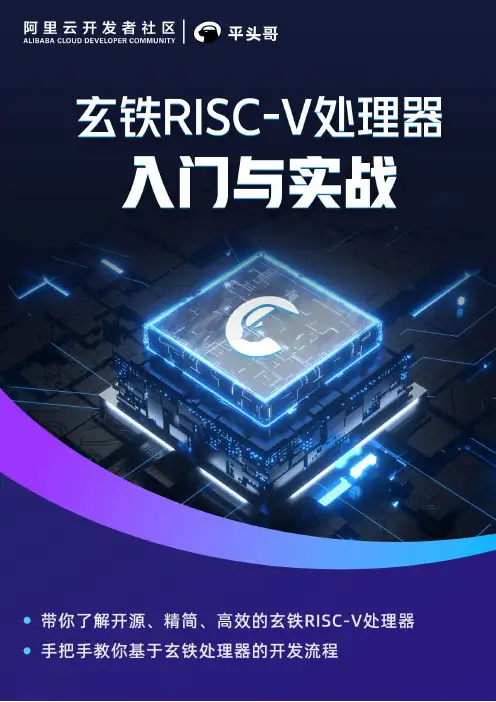
扫码注册平头哥OCC 官网观看各类视频及课程阿里云开发者“藏经阁”海量电子手册免费下载平头哥芯片开放社区交流群扫码关注获取更多信息平头哥RISC-V 系列课程培训扫码登录在线学习目录RISC-V处理器架构 (5)1.RISC-V架构起源 (5)2.RISC-V架构发展 (5)3.RISC-V架构与X86、ARM在商业模式上的区别 (6)4.RISC-V架构现状和未来 (7)5.RISC-V处理器课程学习 (9)平头哥玄铁CPU IP (10)1.概述 (10)2.面向低功耗领域CPU (10)3.面向中高端服务器CPU (16)4.面向高性能领域CPU (23)5.玄铁CPU课程学习 (26)无剑平台 (27)1.无剑100开源SoC平台 (27)2.无剑600SoC平台 (28)平头哥RISC-V工具链 (34)1.RISC-V工具链简介 (34)2.剑池CDK开发工具 (37)3.玄铁CPU调试系统 (44)4.HHB (51)5.剑池CDK开发工具课程学习 (54)平头哥玄铁CPU系统 (55)1.YoC (55)2.Linux (56)3.Android (62)RISC-V玄铁系列开发板实践 (67)1.基于玄铁C906处理器的D1Dock Pro开发实践 (67)2.基于玄铁E906处理器的RVB2601开发实践 (82)RISC-V应用领域开发示例 (100)1.基于D1Dock Pro应用开发示例 (100)2.基于RVB2601应用开发示例 (106)RISC-V未来探索 (116)1.平头哥开源RISC-V系统处理器 (116)2.平头哥对RISC-V基金会贡献 (117)3.高校合作 (117)RISC-V处理器架构1.RISC-V架构起源RISC-V架构是一种开源的指令集架构。
最早是由美国伯克利大学的Krest教授及其研究团队提出的,当时提出的初衷是为了计算机/电子类方向的学生做课程实践服务的。
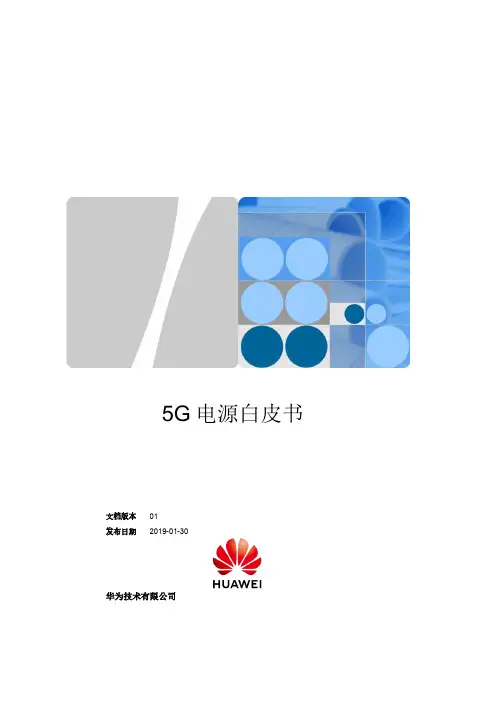
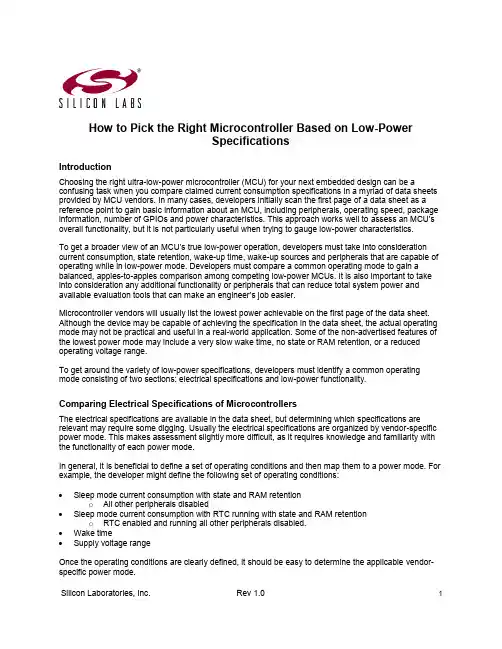
How to Pick the Right Microcontroller Based on Low-PowerSpecificationsIntroductionChoosing the right ultra-low-power microcontroller (MCU) for your next embedded design can be a confusing task when you compare claimed current consumption specifications in a myriad of data sheets provided by MCU vendors. In many cases, developers initially scan the first page of a data sheet as a reference point to gain basic information about an MCU, including peripherals, operating speed, package information, number of GPIOs and power characteristics. This approach works well to assess an MCU’s overall functionality, but it is not particularly useful when trying to gauge low-power characteristics.To get a broader view of an M CU’s true low-power operation, developers must take into consideration current consumption, state retention, wake-up time, wake-up sources and peripherals that are capable of operating while in low-power mode. Developers must compare a common operating mode to gain a balanced, apples-to-apples comparison among competing low-power MCUs. It is also important to take into consideration any additional functionality or peripherals that can reduce total system power and available evaluation tools that can make an engineer’s job easier.Microcontroller vendors will usually list the lowest power achievable on the first page of the data sheet. Although the device may be capable of achieving the specification in the data sheet, the actual operating mode may not be practical and useful in a real-world application. Some of the non-advertised features of the lowest power mode may include a very slow wake time, no state or RAM retention, or a reduced operating voltage range.To get around the variety of low-power specifications, developers must identify a common operating mode consisting of two sections: electrical specifications and low-power functionality.Comparing Electrical Specifications of MicrocontrollersThe electrical specifications are available in the data sheet, but determining which specifications are relevant may require some digging. Usually the electrical specifications are organized by vendor-specific power mode. This makes assessment slightly more difficult, as it requires knowledge and familiarity with the functionality of each power mode.In general, it is beneficial to define a set of operating conditions and then map them to a power mode. For example, the developer might define the following set of operating conditions:∙Sleep mode current consumption with state and RAM retentiono All other peripherals disabled∙Sleep mode current consumption with RTC running with state and RAM retentiono RTC enabled and running all other peripherals disabled.∙Wake time∙Supply voltage rangeOnce the operating conditions are clearly defined, it should be easy to determine the applicable vendor-specific power mode.Additional Low-Power FunctionalityThe second section, low-power functionality, is not as easy to locate in the vendor’s documentation and may be spread across the data sheet and reference manual. Examples of low-power functionality include: ∙Available wake sources∙How code resumes execution∙Peripherals capable of operating in sleep mode.Once the common operating mode has been clearly defined, developers can begin to examine the documentation in more detail.While going through this exercise of compiling data, keep in mind that there may be some MCU-specific features that can further optimize an application for ultra-low power. Optimizations may reduce bill of material (BOM) costs, provide longer product life or provide greater design flexibility. For example, an on-chip dc-dc converter can efficiently provide power to the system and decrease power consumption. This can enable the use of smaller batteries, which will decrease the overall BOM costs, or provide power budget flexibility. A variety of wake sources can provide design flexibility and allow the microcontroller to stay in the lowest power mode as long as possible, further reducing the average current consumption of the application.Allowing firmware to scale the internal supply voltage is another optimization knob available to the developer. If an MCU is operating at a slow frequency, it may be possible to decrease the supply voltage and save power. Selective clock gating allows hardware blocks to be disconnected from the active circuits, preventing inactive peripherals from consuming power. These types of features are not comprehended by supply current specifications that are commonly used to rank low-power MCUs, but are critical to achieving the lowest overall system power consumption.Reducing Complexity Using ToolsAs MCUs become more and more configurable to achieve the lowest power consumption, they also can become more complex. To cope with this increased complexity, developers should take a close look at the evaluation platforms available for an MCU and the overall ease of implementing a solution. For example, the development board and software tools used to program the MCU should be intuitive and easy-to-use. Hardware that is difficult to understand or use is not likely to lead to an easy firmware development process. From a firmware perspective, MCU vendors should supply firmware examples that can recreate specifications from the data sheet. If advertised current consumption specifications cannot be recreated on an evaluation platform, it is likely that it will be just as difficult (if not impossible) to configure the MCU to achieve these numbers on custom hardware. Giving customers a variety of code examples that can be used as a starting point for their code development can reduce time-to-market and help engineers learn to use a device.Graphical configuration tools can aid in development and help the developer gain a deeper understanding of an MCU. When developing low-power applications, it is helpful to know where the total consumed power is going. This information is useful because it highlights what aspect of a design needs to be further optimized and can also help the developer understand the overall architecture of the device. Ideally, low-power configuration tools could give tips on further reducing power as well as highlight any configuration errors that were detected throughout the configuration process. For example, the Power Estimator utility within Silicon Labs’ AppBuilder graphical configuration tool provides Power Tips that give configuration guidance and a power-budget pie chart showing how much power is consumed and which peripherals are consuming the power. As configuration changes are made, the pie chart automatically updates.Figure 1. Power Estimator Enables Developers to Optimize for Lowest Current Consumption To facilitate the microcontroller comparison process, the following table provides a list of common operating modes, as well as system-level optimizations and development tools available for Silicon Labs’32-bit SiM3L1xx MCUs based on the ARM® Cortex™-M3 core.SummaryEvaluating and selecting a microcontroller for a low-power application requires more than a quick scan of the first page of the data sheet. Determining which MCU provides the lowest overall system power requires developers to know the device’s supply current specifications, as well as any system-level optimizations that can reduce the overall supply current.Unfortunately, each MCU vendor specifies operating conditions differently and in some cases advertises a low-power number that is available in an unusable mode. Using a common operating mode to compare MCUs will prevent developers from being misled by vendor claims of ultra-low-power operation.Once the electrical characteristics of a device are understood and quantified, developers should take a look at the evaluation platform and software tools available. These considerations are crucial in getting an engineering team up and running quickly and should be included in the final microcontroller selection process. Find out more about Silicon Labs’ microcontrollers, including 8-bit and 32-bit MCUs at/mcu.# # #Silicon Labs invests in research and development to help our customers differentiate in the market with innovative low-power, small size, analog intensive, mixed-signal solutions. Silicon Labs' extensive patent portfolio is a testament to our unique approach and world-class engineering team. Patent: /patent-notice© 2013, Silicon Laboratories Inc. ClockBuilder, DSPLL, Ember, EZMac, EZRadio, EZRadioPRO, EZLink, ISOmodem, Precision32, ProSLIC, QuickSense, Silicon Laboratories and the Silicon Labs logo are trademarks or registered trademarks of Silicon Laboratories Inc. ARM and Cortex-M3 are trademarks or registered trademarks of ARM Holdings. ZigBee is a registered trademark of ZigBee Alliance, Inc. All other product or service names are the property of their respective owners.。
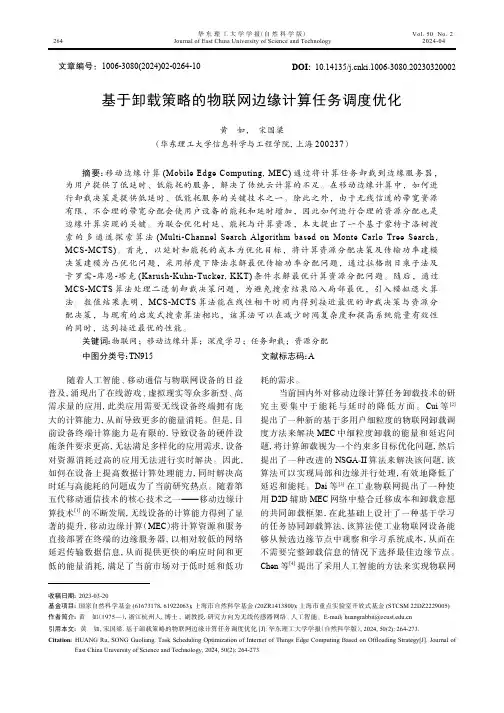
文章编号:1006-3080(2024)02-0264-10DOI: 10.14135/ki.1006-3080.20230320002基于卸载策略的物联网边缘计算任务调度优化黄 如, 宋国梁(华东理工大学信息科学与工程学院, 上海200237)摘要:移动边缘计算(Mobile Edge Computing, MEC)通过将计算任务卸载到边缘服务器,为用户提供了低延时、低能耗的服务,解决了传统云计算的不足。
在移动边缘计算中,如何进行卸载决策是提供低延时、低能耗服务的关键技术之一。
除此之外,由于无线信道的带宽资源有限,不合理的带宽分配会使用户设备的能耗和延时增加,因此如何进行合理的资源分配也是边缘计算实现的关键。
为联合优化时延、能耗与计算资源,本文提出了一个基于蒙特卡洛树搜索的多通道探索算法(Multi-Channel Search Algorithm based on Monte Carlo Tree Search ,MCS-MCTS)。
首先,以延时和能耗的成本为优化目标,将计算资源分配决策及传输功率建模决策建模为凸优化问题,采用梯度下降法求解最优传输功率分配问题,通过拉格朗日乘子法及卡罗需-库恩-塔克(Karush-Kuhn-Tucker, KKT)条件求解最优计算资源分配问题。
随后,通过MCS-MCTS 算法处理二进制卸载决策问题,为避免搜索结果陷入局部最优,引入模拟退火算法。
数值结果表明,MCS-MCTS 算法能在线性相干时间内得到接近最优的卸载决策与资源分配决策,与现有的启发式搜索算法相比,该算法可以在减少时间复杂度和提高系统能量有效性的同时,达到接近最优的性能。
关键词:物联网;移动边缘计算;深度学习;任务卸载;资源分配中图分类号:TN915文献标志码:A 随着人工智能、移动通信与物联网设备的日益普及,涌现出了在线游戏、虚拟现实等众多新型、高需求量的应用,此类应用需要无线设备终端拥有庞大的计算能力,从而导致更多的能量消耗。
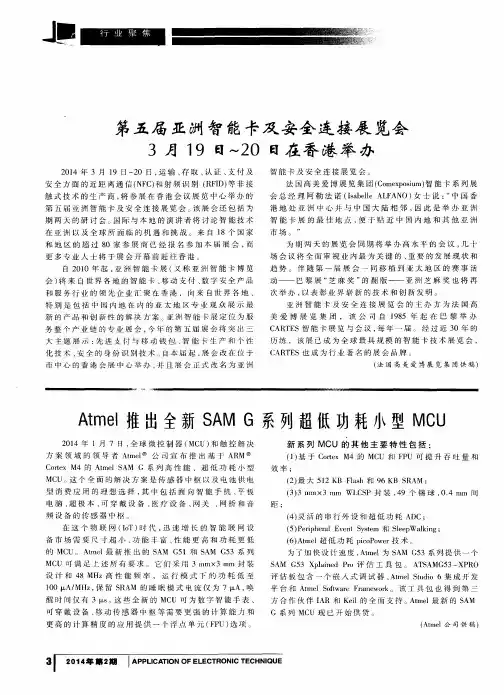
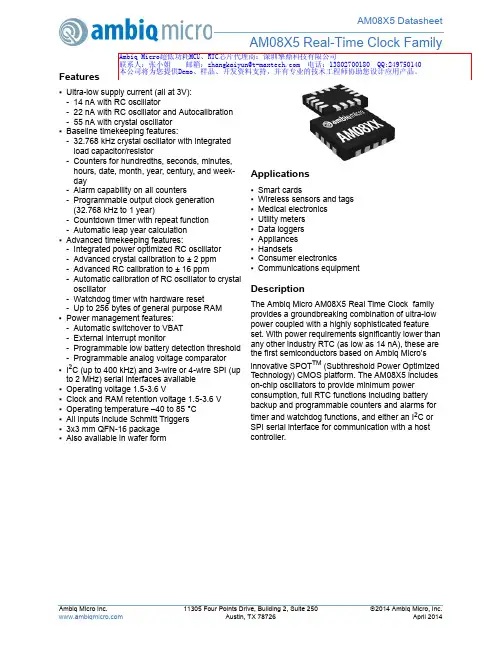
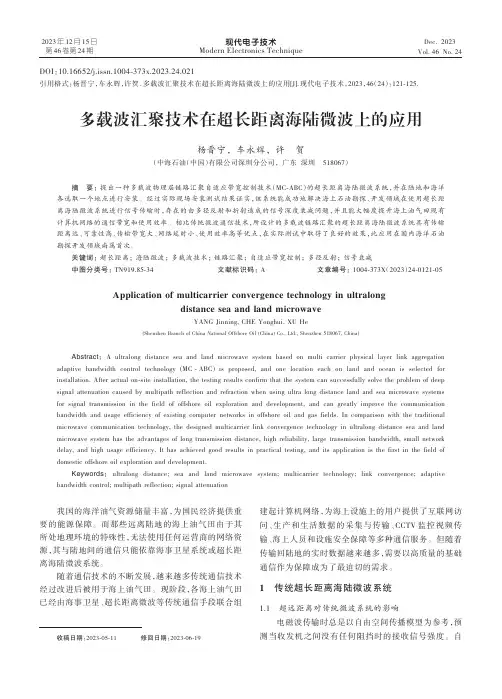
现代电子技术Modern Electronics TechniqueDec. 2023Vol. 46 No. 242023年12月15日第46卷第24期我国的海洋油气资源储量丰富,为国民经济提供重要的能源保障。
而那些远离陆地的海上油气田由于其所处地理环境的特殊性,无法使用任何运营商的网络资源,其与陆地间的通信只能依靠海事卫星系统或超长距离海陆微波系统。
随着通信技术的不断发展,越来越多传统通信技术经过改进后被用于海上油气田。
现阶段,各海上油气田已经由海事卫星、超长距离微波等传统通信手段联合组建起计算机网络,为海上设施上的用户提供了互联网访问、生产和生活数据的采集与传输、CCTV 监控视频传输、海上人员和设施安全保障等多种通信服务。
但随着传输回陆地的实时数据越来越多,需要以高质量的基础通信作为保障成为了最迫切的需求。
1 传统超长距离海陆微波系统1.1 超远距离对传统微波系统的影响电磁波传输时总是以自由空间传播模型为参考,预测当收发机之间没有任何阻挡时的接收信号强度。
自DOI :10.16652/j.issn.1004‐373x.2023.24.021引用格式:杨晋宁,车永辉,许贺.多载波汇聚技术在超长距离海陆微波上的应用[J].现代电子技术,2023,46(24):121‐125.多载波汇聚技术在超长距离海陆微波上的应用杨晋宁, 车永辉, 许 贺(中海石油(中国)有限公司深圳分公司, 广东 深圳 518067)摘 要: 提出一种多载波物理层链路汇聚自适应带宽控制技术(MC‐ABC )的超长距离海陆微波系统,并在陆地和海洋各选取一个地点进行安装。
经过实际现场安装测试结果证实,该系统能成功地解决海上石油勘探、开发领域在使用超长距离海陆微波系统进行信号传输时,存在的由多径反射和折射造成的信号深度衰减问题,并且能大幅度提升海上油气田现有计算机网络的通信带宽和使用效率。
相比传统微波通信技术,所设计的多载波链路汇聚的超长距离海陆微波系统具有传输距离远、可靠性高、传输带宽大、网络延时小、使用效率高等优点,在实际测试中取得了良好的效果,此应用在国内海洋石油勘探开发领域尚属首次。
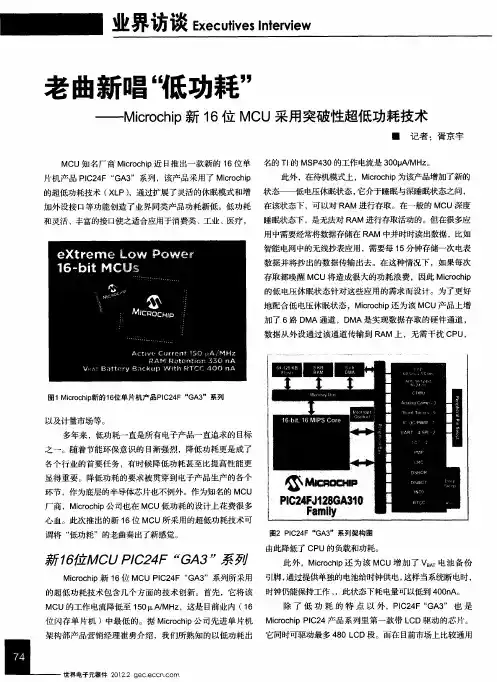
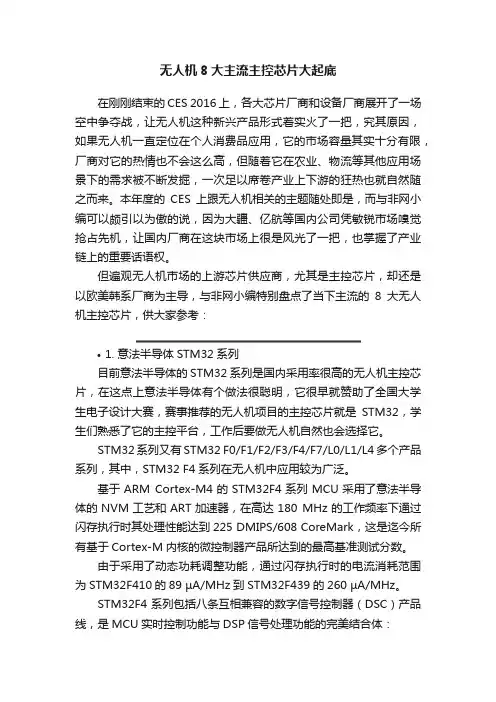
无人机8大主流主控芯片大起底在刚刚结束的CES 2016上,各大芯片厂商和设备厂商展开了一场空中争夺战,让无人机这种新兴产品形式着实火了一把,究其原因,如果无人机一直定位在个人消费品应用,它的市场容量其实十分有限,厂商对它的热情也不会这么高,但随着它在农业、物流等其他应用场景下的需求被不断发掘,一次足以席卷产业上下游的狂热也就自然随之而来。
本年度的CES上跟无人机相关的主题随处即是,而与非网小编可以颇引以为傲的说,因为大疆、亿航等国内公司凭敏锐市场嗅觉抢占先机,让国内厂商在这块市场上很是风光了一把,也掌握了产业链上的重要话语权。
但遍观无人机市场的上游芯片供应商,尤其是主控芯片,却还是以欧美韩系厂商为主导,与非网小编特别盘点了当下主流的8大无人机主控芯片,供大家参考:•1. 意法半导体STM32系列目前意法半导体的STM32系列是国内采用率很高的无人机主控芯片,在这点上意法半导体有个做法很聪明,它很早就赞助了全国大学生电子设计大赛,赛事推荐的无人机项目的主控芯片就是STM32,学生们熟悉了它的主控平台,工作后要做无人机自然也会选择它。
STM32系列又有STM32 F0/F1/F2/F3/F4/F7/L0/L1/L4多个产品系列,其中,STM32 F4系列在无人机中应用较为广泛。
基于ARM Cortex-M4的STM32F4系列MCU采用了意法半导体的NVM工艺和ART加速器,在高达180 MHz的工作频率下通过闪存执行时其处理性能达到225 DMIPS/608 CoreMark,这是迄今所有基于Cortex-M内核的微控制器产品所达到的最高基准测试分数。
由于采用了动态功耗调整功能,通过闪存执行时的电流消耗范围为STM32F410的89 µA/MHz到STM32F439的260 µA/MHz。
STM32F4系列包括八条互相兼容的数字信号控制器(DSC)产品线,是MCU实时控制功能与DSP信号处理功能的完美结合体:•高级系列•· STM32F469/479 – 180 MHz CPU/225 DMIPS,高达2 MB 的双区闪存,带SDRAM和QSPI接口,Chrom-ART Accelerator™、LCD-TFT控制器和MPI-DSI接口•· STM32F429/439 – 180 MHz CPU/225 DMIPS,高达2MB的双区闪存,具有SDRAM接口,Chrom-ART Accelerator™ 和LCD-TFT控制器•· STM32F427/437 – 180 MHz CPU/225 DMIPS,高达2 MB 的双区闪存,具有SDRAM接口、Chrom-ART Accelerator™、串行音频接口,性能更高,静态功耗更低•基础系列•· STM32F446 – 180 MHz/225 DMIPS,高达512 KB的Flash,具有Dual Quad SPI和SDRAM接口•· STM32F407/417 – 168 MHz CPU/210 DMIPS,高达1MB的Flash,增加了以太网MAC和照相机接口•· STM32F405/415 – 168 MHz CPU/210 DMIPS,高达1MB的Flash、具有先进连接功能和加密功能•基本型系列•· STM32F411 – 100 MHz CPU/125 DMIPS,具有卓越的功率效率,更大的SRAM和新型智能DMA,优化了数据批处理的功耗(采用批采集模式的动态效率系列)•· STM32F410 – 100 MHz CPU/125 DMIPS,为卓越的功率效率性能设立了新的里程碑(停机模式下89 µA/MHz和6 µA),采用新型智能DMA,优化了数据批处理的功耗(采用批采集模式的动态效率™系列),配备真随机数发生器、低功耗定时器和DAC•· STM32F401 – 84 MHz CPU/105 DMIPS,尺寸最小、成本最低的解决方案,具有卓越的功耗效率(动态效率系列)•2. 高通骁龙Flight平台在CES2016上,Qualcomm Incorporated子公司QualcommTechnologies、腾讯和零度智控发布并展示了一款基于高通骁龙Flight平台的商用无人机YING,将于2016年上半年在全球上市。
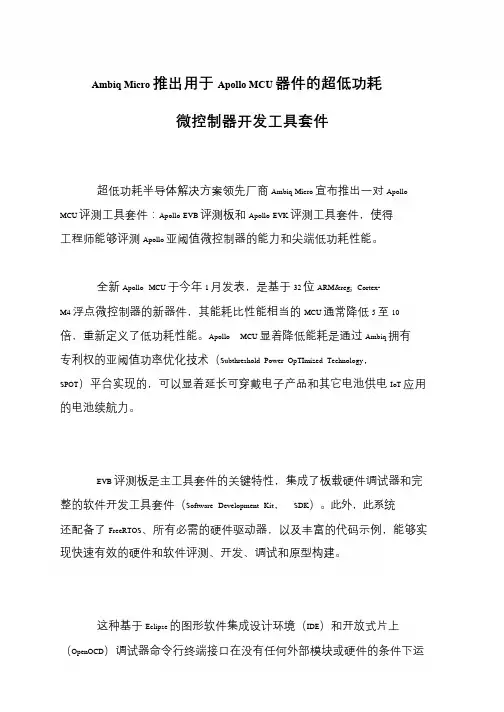
Ambiq Micro 推出用于Apollo MCU 器件的超低功耗
微控制器开发工具套件
超低功耗半导体解决方案领先厂商Ambiq Micro 宣布推出一对Apollo MCU 评测工具套件:Apollo EVB 评测板和Apollo EVK 评测工具套件,使得
工程师能够评测Apollo 亚阈值微控制器的能力和尖端低功耗性能。
全新Apollo MCU 于今年1 月发表,是基于32 位ARM® Cortex- M4 浮点微控制器的新器件,其能耗比性能相当的MCU 通常降低5 至10
倍,重新定义了低功耗性能。
Apollo MCU 显着降低能耗是通过Ambiq 拥有
专利权的亚阈值功率优化技术(Subthreshold Power OpTImized Technology,SPOT)平台实现的,可以显着延长可穿戴电子产品和其它电池供电IoT 应用
的电池续航力。
EVB 评测板是主工具套件的关键特性,集成了板载硬件调试器和完
整的软件开发工具套件(Software Development Kit,SDK)。
此外,此系统还配备了FreeRTOS、所有必需的硬件驱动器,以及丰富的代码示例,能够实
现快速有效的硬件和软件评测、开发、调试和原型构建。
这种基于Eclipse 的图形软件集成设计环境(IDE)和开放式片上(OpenOCD)调试器命令行终端接口在没有任何外部模块或硬件的条件下运。
增强性能低成本M-BUS接口芯片(SE722)1、简介Meter-BUS(简称“M-BUS”)是一种专门用于各种类型仪表、控制装置的远程通信的总线系统。
SE722是专门针对M-BUS通信标准设计生产的仪表总线专用终端收发接口芯片,芯片采用ESOP8封装,将整个数据发送与接收功能集成于一体,可使用最少的外围元器件实现高可靠性能的终端总线接口。
SE722内部除了符合M-BUS标准的接收发送电路外,还包含一个可调节电源,可为终端提供最大7.5mA输出电流,特殊应用下可为终端提供20mA 的输出电流。
2、特点◆完全符合M-BUS国际标准和国家标准;◆总线电流600uA—3mA连续可设置;◆总线电压15V-42V均可适应;◆增强的5V/3.3V稳压输出可提供最大超过20mA输出电流,SE722A为5V输出,SE722B为3.3V输出;◆ESOP8封装,最少只需3只外围元件;◆300—19200BPS通信速率;◆支持UART协议,只在数据传输时总线有效。
3、应用领域◆智能水表气表热量表抄表◆智能电网自动抄表◆智能家庭控制网络◆消防报警及联动网络◆中央空调控制系统◆智能传感器网络4、典型应用电路图1.0 SE722典型应用电路5、管脚描述注释1:VDO输出电流的能力,取决于编程电阻的大小,见图7.0所示。
除去SE722自身要消耗的电流外,其余可由VDO输出;另外,当客户需要短时的大电流输出时,可将RXD拉低,此时VDO的输出电流能力可达20mA。
6、原理框图图2.0 SE722内部结构框图7、工作原理1,主→从此模式下采用电压调制传输数据,总线电流保持不变。
即主机发送的数据码流是一种电压脉冲序列,用+36V 标识逻辑‘1’,用+24V 标识逻辑‘0’。
在稳态时,线路将保持‘1’状态。
如图3.0 所示:图3.0 SE722接收时序图连接在管脚RXC上的电容C RXC的充放电流是不同的,存在以下关系:I SCcharge=I SCdischage/40这个比例关系是独立于数据内容运行任意UART协议所必须的条件(例如,传输采用11位UART协议,当所有数据只有停止位是“1”,其他都是“0”),必须有足够的时间对电容C RXC进行再充电,内部电压比较器TC3检测来自主机的调制电压,并根据电压VIN=SPACE 或MARK来开关,正端输出TXD,输出数据给从机。
瑞萨电子计量用超低功耗MCU亮相MeteringChina2010佚名
【期刊名称】《卫视传媒》
【年(卷),期】2010(000)018
【摘要】全球领先半导体厂商瑞萨电子携经销商世强于9月14日-16日,与NEC集团旗下光通信器件事业部,山梨日本电气株式会社(简称NEC山梨)联合参加由能源计量领域的专业媒体《环球表计》与北京金思朗咨询公司共同举办的“2010中国城镇供水/城市燃气智能计量技术、自动抄表及智能网发展国际论坛暨展会”。
【总页数】1页(P13-13)
【正文语种】中文
【中图分类】TN305
【相关文献】
1.变革,为给客户提供更好的服务——瑞萨电子(上海)有限公司北京分公司总经理常清璞谈2009年瑞萨MCU中国战略及解决方案
2.以高算力和超低功耗赋能MCU,瑞萨为AIoT应用增添新活力\r——访瑞萨电子中国产业解决方案中心高级总监徐征
3.瑞萨电子RA产品家族新增超低功耗RA2L1 MCU产品群
4.专访瑞萨电子大中国区汽车电子解决方案销售中心赵明宇总监 MCU/SoC助力本土车企追赶世界
5.瑞萨电子推出超低功耗ZMOD4510户外空气质量传感器平台
因版权原因,仅展示原文概要,查看原文内容请购买。
Ambiq Micro:举起物联网时代低功耗MCU大旗王丽英【期刊名称】《今日电子》【年(卷),期】2016(000)002【总页数】2页(P71-72)【作者】王丽英【作者单位】【正文语种】中文物联网的口号已经喊了好几年了,如何让物联网应用落地,让万物互联的时代早日到来,这是产业链上下游众多厂商迫切要解决的问题。
作为电子设备控制核心的微控制器(MCU)产品,在物联网时代迎来了更广阔的商机,同时,物联网应用的新特性也为MCU的发展带来了诸多挑战。
针对物联网时代MCU的发展前景,Ambiq Micro公司接受了本刊的专访,阐释了物联网时代给MCU带来的诸多挑战和机遇,Ambiq Micro市场营销高级总监Keith Odland表示,“能量障碍(energy barrier)”将是未来的挑战之一,IoT设备的功能要求与功率预算之间存在着巨大的鸿沟,在这道鸿沟被弥补之前,是不可能出现人们所期待的IoT设备的爆发增长的。
《今日电子》:物联网的口号已经喊了好几年了,《中国制造2025》的发布无疑让这股潮流来得更为迅猛,作为MCU厂商,您如何看待物联网的发展?Ambiq Micro市场营销高级总监Keith Odland:实现物联网(IoT)功能的设备和传感器数量正在以指数速率增长,传感器的数量和多样性均发展迅速,这推动业界采用更多的传感器融合应用。
未来的挑战可能是由于“能量障碍(energy barrier)”,许多有价值的应用不可能实现。
这就是说,功能的要求超出了可用的功率预算。
在PC中,我们看到笔记本电脑能够持续使用整个会议时间,或数小时飞机航程时间。
对于蜂窝手机来说,是使用一天时间,而可穿戴产品则使用数周或数月,对于IoT设备来说,就是使用数年和数十年。
这类应用所需传感器的种类和数量发展快速,而且,这些传感器在所需时间内工作所需的能量与实际可能有一定缺口。
在这道鸿沟被弥补之前,不可能出现人们所期待的IoT设备的大规模增长,这是因为没有人想要每天为500亿台IoT设备更换电池和给电池充电。
Energy Micro 宣布“Wonder Gecko”系列MCU 已正
式量产
挪威,奥斯陆,05/23/2013-节能微控器和无线射频供应商Energy Micro 宣布其最新、且最先进的EFM32 微控制器系列-Wonder Gecko 系列微控制器包括相关开发工具,现已正式发售。
Wonder Gecko 系列微控制器基于ARM Cortex-M4 内核,提供完整的DSP 指令集及一个专用的浮点运算单元。
为了使得MCU 在运行模式和睡眠状态下获得最低的功耗,EFM32 Wonder Gecko 系列还融入了eLL(超低漏电流工艺)技术。
Energy Micro 的CTO(首席技术官)Øyvind Janbu 说,嵌入式设计人员一直希望在较高温度下仍可以获得较低的待机电流。
为了满足这
一需求,我们和台积电合作利用新的技术使系统在85 度C 时的功耗降低了
一半。
将低睡眠电流与Cortex-M4 具有的浮点性能及DSP 指令集相结合使得MCU 可以收集并处理大量的数据-比如传感器读数,运算所需时间仅占其
他类型MCU 所需时间的一小部分,而且能更快地进入超低功耗的睡眠模
式。
Wonder Gecko 系列包括60 款产品。
可扩展内存具有高达256 KB 闪存及32 KB RAM。
该系列亦具有QFN64,BGA120 等多种封装选择。
每款产品都包括LESENSE,LETIMER,PRS,USB 及TFT/LCD 驱动等有自主操作性能的Gecko 低功耗外设或接口,构成完整的片上系统解决方案。
Ambiq Micro 超低功耗MCU 突破EEMBC®
ULPBench™限值翻倍最高分数记录
超低功耗半导体解决方案领先厂商Ambiq Micro 宣布其Apollo 微控制器(MCU)创造了微控制器的历史性记录,按照业界标准EEMBC ULPBench 基准测试,Apollo MCU 所消耗的能量低于其它任何微控制器产品的一半。
EEMBC ULPBench 基准是帮助嵌入式设计人员选择最低功耗MCU 而创建,针对典型低功耗设计工作负荷进行标准化,并测量完成工作负荷所需的实际能量。
这种方法对有功电流、睡眠电流、唤醒时间、内核效率,以及缓存效率等MCU 运作的许多不同行为特性规范化,然后将这些数据合成
为开发人员真正关注的单一数值,即是完成具体应用所需要的能量。